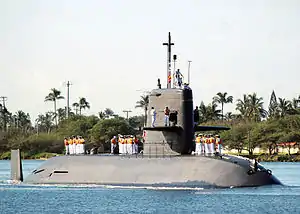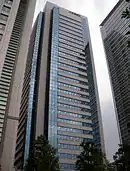Oyashio-class submarine
The Oyashio class is a series of Japanese diesel-electric attack submarines operated by the JMSDF. The submarines entered service in the late 1990s. The submarines are larger than the earlier Harushio class, to provide space for a flank sonar array.
 Oyashio at Pearl Harbor in 2006 | |
| Class overview | |
|---|---|
| Name: | Oyashio (おやしお, Oyashio Current) |
| Builders: | |
| Operators: |
|
| Preceded by: | Harushio class |
| Succeeded by: | Sōryū class |
| Built: | 1994–2008 |
| In commission: | 1998–present |
| Planned: | 11 |
| Completed: | 11 |
| Active: | 9 (2 converted to training ships) |
| General characteristics | |
| Type: | Attack submarine |
| Displacement: | |
| Length: | 81.7 m (268 ft 1 in) |
| Beam: | 8.9 m (29 ft 2 in) |
| Draught: | 7.4 m (24 ft 3 in) |
| Propulsion: |
|
| Speed: |
|
| Complement: | 70 (10 officers) |
| Sensors and processing systems: |
|
| Armament: |
|
Boats
There are a total of 11 boats in the class - the last boat was commissioned in 2008. Oyashio, Michishio, and Kuroshio share their names with World War II destroyers Takashio shares a name with a third set of Yūgumo-class destroyers, of which none were built.
The first two boats, Oyashio and Michishio, have since been converted to training platforms.
On February 1, 2018, the Ministry of Defence's Maritime Staff Office revealed that seven of the service's 82-metre (269 ft 0 in) Oyashio-class submarines, which have a surface displacement of 2,800 tonnes – have already completed service-life extension work to date. The seven boats received extensive refits during their second and third maintenance cycles, which have been planned to bring the vessels to "almost the same level of that of the latest model Sōryū-class submarine, while extending their service lives.[1]
| Project no. | Building no. | Pennant no. | Name | Laid down | Launched | Commissioned | Shipyard | Note |
|---|---|---|---|---|---|---|---|---|
| S130 | 8105 | SS-590/ TSS-3608 | Oyashio (おやしお) | 26 January 1994 | 15 October 1996 | 16 March 1998 | Kawasaki Shipbuilding Corporation, Kobe[2] | Converted to training submarine (TSS-3608) on 6 March 2015 |
| 8106 | SS-591 | Michishio (みちしお) | 16 February 1995 | 18 September 1997 | 10 March 1999 | Mitsubishi Heavy Industries, Kobe | Converted to training submarine (TSS-3609) on 27 February 2017 | |
| 8107 | SS-592 | Uzushio (うずしお) | 6 March 1996 | 26 November 1998 | 9 March 2000 | Kawasaki Shipbuilding Corporation, Kobe | ||
| 8108 | SS-593 | Makishio (まきしお) | 26 March 1997 | 22 September 1999 | 29 March 2001 | Mitsubishi Heavy Industries, Kobe | ||
| 8109 | SS-594 | Isoshio (いそしお) | 9 March 1998 | 27 November 2000 | 14 March 2002 | Kawasaki Shipbuilding Corporation, Kobe | ||
| 8110 | SS-595 | Narushio (なるしお) | 2 April 1999 | 4 October 2001 | 3 March 2003 | Mitsubishi Heavy Industries, Kobe | ||
| 8111 | SS-596 | Kuroshio (くろしお) | 27 March 2000 | 23 October 2002 | 8 March 2004 | Kawasaki Shipbuilding Corporation, Kobe | ||
| 8112 | SS-597 | Takashio (たかしお) | 30 January 2001 | 1 October 2003 | 9 March 2005 | Mitsubishi Heavy Industries, Kobe | ||
| 8113 | SS-598 | Yaeshio (やえしお) | 15 January 2002 | 4 November 2004 | 9 March 2006 | Kawasaki Shipbuilding Corporation, Kobe | ||
| 8114 | SS-599 | Setoshio (せとしお) | 23 January 2003 | 5 October 2005 | 28 February 2007 | Mitsubishi Heavy Industries, Kobe | ||
| 8115 | SS-600 | Mochishio (もちしお) | 23 February 2004 | 6 November 2006 | 6 March 2008 | Kawasaki Shipbuilding Corporation, Kobe |
Gallery
_departs_Joint_Base_Pearl_Harbor-Hickam_to_support_Rim_of_the_Pacific_(RIMPAC)_2010_exercises.jpg.webp) JS Mochisio (SS 600) departs Joint Base Pearl Harbor-Hickam to support Rim of the Pacific (RIMPAC) 2010 exercises.
JS Mochisio (SS 600) departs Joint Base Pearl Harbor-Hickam to support Rim of the Pacific (RIMPAC) 2010 exercises. Oyashio-class submarine.
Oyashio-class submarine. Oyashio-class submarine.
Oyashio-class submarine. JS Kuroshio (SS 596) at the Maizuru Naval Base.
JS Kuroshio (SS 596) at the Maizuru Naval Base. JS Narushio (SS 595) pulls into Pearl Harbor for a scheduled port call before starting Rim of the Pacific (RIMPAC) 2008.
JS Narushio (SS 595) pulls into Pearl Harbor for a scheduled port call before starting Rim of the Pacific (RIMPAC) 2008..jpg.webp) JS Yaeshio (SS 598) arrives at Naval Station Pearl Harbor for an annual training exercise.
JS Yaeshio (SS 598) arrives at Naval Station Pearl Harbor for an annual training exercise._arrives_at_Joint_Base_Pearl_Harbor-Hic.jpg.webp) JS Uzushio (SS 592) arrives at Joint Base Pearl Harbor-Hickam to begin their annual training exercise.
JS Uzushio (SS 592) arrives at Joint Base Pearl Harbor-Hickam to begin their annual training exercise._arrives_at_Joint_Base_Pearl_Harbor-Hickam_to_support_Rim_of_the_Pacific_(RIMPAC)_exercises.jpg.webp) JS Mochishio (SS 600) arrives at Joint Base Pearl Harbor-Hickam to support Rim of the Pacific (RIMPAC) exercises.
JS Mochishio (SS 600) arrives at Joint Base Pearl Harbor-Hickam to support Rim of the Pacific (RIMPAC) exercises. Oyashio-class submarine profile
Oyashio-class submarine profile
See also
References
- "Japan outlines submarine modernisation efforts". February 1, 2018. Archived from the original on March 2, 2018. Retrieved March 1, 2018.
- Saunders, Stephen (2004). Jane's Fighting Ships 2004-2005. Jane's Information Group. p. 384. ISBN 0-7106-2623-1.

